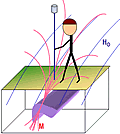Magnetics

Measurements of the magnetic field contain information about subsurface variations in magnetic susceptibility. Data can be acquired in the air (planes, satellites), on the ground (stationary, moving platforms, marine) and underground (boreholes, tunnels). The measurements record the sum of Earth’s field and fields induced in magnetic materials. More magnetic (i.e. susceptible) materials have stronger induced fields. Removing Earth’s field from the observations yields anomalous fields that can be interpreted in terms of where magnetic material lies and also its susceptiblity and shape. Processed data are presented as maps or profiles, and advanced processing, involving inversion, yields parametric structures or 3D models of the subsurface susceptibility distribution. Magnetic surveying is extremely versatile and can be applied in many areas in the geosciences including geologic mapping, mineral exploration, unexploded ordnance detection, and archeology.
Contents: